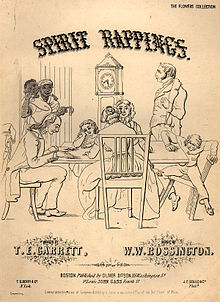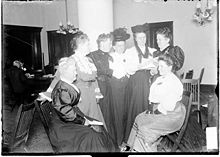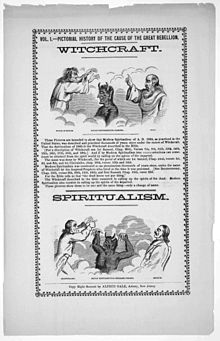Spiritualism (movement)
Spiritualism is a religious movement, prominent from the 1840s to the 1920s, found primarily in English-speaking countries. The movement's distinguishing feature is the belief that the spirits of the dead can be contacted by mediums. These spirits are believed to lie on a higher spiritual plane than humans, and are therefore capable of providing guidance in both worldly and spiritual matters. Spiritualism is closely related to Spiritism, a religious movement that originated in France, and is today widespread in Brazil and other Latin countries.

Origins
Modern Spiritualism first appeared in the 1840s in the Burned-Over District of upstate New York where earlier religious movements such as Millerism (Seventh Day Adventists) and Mormonism had emerged during the Second Great Awakening. It was an environment in which many people felt that direct communication with God or angels was possible, and in which many people felt uncomfortable with Calvinist notions that God would behave harshly — for example, that God would condemn unbaptized infants to an eternity in hell (Carroll 1997).
Swedenborg and Mesmer
In this environment the writings of Emanuel Swedenborg (1688-1772) and the teachings of Franz Mesmer (1734-1815) provided an example for those seeking direct personal knowledge of the afterlife (Carroll 1997). Swedenborg, who in trance states would commune with spirits, described in his voluminous writings the structure of the spirit world. Two features of his view particularly resonated with the early Spiritualists: first, that there is not a single hell and a single heaven, but rather a series of spheres through which a spirit progresses as it develops; second, that spirits mediate between God and humans, so that human direct contact with the divine is through the spirits of deceased humans.
Mesmer did not contribute religious beliefs, but he contributed a technique, latter known as hypnotism, that could induce trances and cause subjects to report contact with spiritual beings. There was a great deal of showmanship in Mesmerism, and the practitioners who lectured in mid-nineteenth century America sought to entertain audiences as well as demonstrate a method for personal contact with the divine.

Perhaps the best known of those who combined Swedenborg and Mesmer in a peculiarly American synthesis is Andrew Jackson Davis who called his system the Harmonial Philosophy. Davis was a practicing hypnotist, faith healer and clairvoyant from Poughkeepsie, New York. His 1847 book The Principles of Nature, Her Divine Revelations, and a Voice to Mankind[1], dictated to a friend while in trance, eventually became the nearest thing to a canonical work in a Spiritualist movement whose extreme individualism precluded the development of a single coherent worldview (Carroll 1997; Braude 2001).
Linked to the Reform Movement
Many of the early participants in Spiritualism were radical Quakers and others caught up in the reforming movement of the mid-nineteenth century. These reformers were uncomfortable with established churches because those churches did little to fight slavery and even less to advance women's rights. Women were particularly attracted to the movement, because it gave them important roles as mediums and trance lecturers. In fact Spiritualism provided one of the first forums in which American women could address mixed public audiences (Braude 2001).
Physical Manifestations and Fraud
Spiritualists often set March 31, 1848 as the beginning of their movement. On that date, Kate and Margaret Fox, of Hydesville, New York, reported that they had made contact with the spirit of a murdered pedlar. What made this an extraordinary event was that the spirit communicated through audible rapping noises, rather than simply appearing to a person in a trance. The evidence of the senses appealed to practical Americans, and the Fox sisters became a sensation. Demonstrations of mediumship (séances and automatic writing, for example) proved to be a profitable venture, and soon became popular forms of entertainment and spiritual catharsis. The Foxes were to earn a living this way and others would follow their lead (Carroll 1997; Braude 2001).
In the following years, showmanship became an increasingly important part of Spiritualism, and the visible, audible, and tangible evidence of spirits escalated as mediums competed for paying audiences. Fraud was certainly widespread, as independent investigating commissions repeatedly established, most notably the 1887 report of the Seybert Commission [2]. Perhaps the best-known case of fraud involved the Davenport Brothers.
But despite widespread fraud, the appeal of Spiritualism was strong. First and foremost, the movement appealed to those grieving the death of a loved one: the resurgence of interest in Spiritualism during and after the first World War was a direct response to the massive number of casualties (Doyle 1926). But the movement also appealed strongly to reformers, who found that the spirits were in favor of such causes du jour as equal rights (Braude 2001).
The movement also appealed to those who had a materialist orientation and had rejected religion. The influential socialist and atheist Robert Owen embraced religion following his experiences in Spiritualist circles. Many scientific men who bothered to investigate the phenomena also ended up being converted. These include the chemist William Crookes, the evolutionary biologist Alfred Russel Wallace (1823-1913)[3], and the physician and author Arthur Conan Doyle (1859-1930)[4] (Doyle 1926).
Widespread but Unorganized
The movement quickly spread throughout the world, though only in the United Kingdom did it become as widespread as in the United States (Britten 1884). In Britain, by 1853, invitations to tea among the prosperous and fashionable often included Table-Turning, a type of séance in which spirits would communicate with people seated around a table by tilting and rotating the table. A particularly important convert was the French academic Allan Kardec (1804-1869), who made the first attempt to systematize Spiritualist practices and ideas into a consistent philosophical system. Kardec's books, written in the last 15 years of his life, became the textual basis of a religious movement called Spiritism, widespread in Latin countries. In Brazil, Kardec's ideas are embraced by millions of followers today (Hess 1987; Carroll 1997; Braude 2001).
American Spiritualists would meet in private homes for séances, at lecture halls for trance lectures, at summer camps attended by thousands, and at state or national conventions. The movement was extremely individualistic, with each Spiritualist relying on her own experiences and reading to discern the nature of the afterlife. Organization was therefore slow to appear, and when it did it was resisted by mediums and trance lecturers. Most Spiritualists were content to attend Christian churches, and Unitarian and particularly Universalist churches contained many Spiritualists. As the movement began to fade, partly through the bad publicity of exposed fraud, partly through the appeal of religious movements such as Christian Science, the Spiritualist Church was organized, and this church can claim to be the main vestige of the movement left today (Carroll 1997; Braude 2001).

Other Prominent Mediums and Believers
Amy Post and Isaac Post were Hicksite Quakers from Rochester, New York. Long acquainted with the Fox family, they took the Fox sisters into their home in the late spring of 1848. As radical Quakers, campaigning for abolition and equal rights for women, they helped put a reform stamp on the movement (Braude 2001).
Achsa W. Sprague was born November 17, 1827, in Plymouth Notch, Vermont. At the age of 20, she became ill with rheumatic fever and credited her eventual recovery to intercession by spirits. An extremely popular trance lecturer, she traveled about the United States until her death in 1861. Like most Spiritualists of her time, Sprague was an abolitionist and an advocate of women's rights (Braude 2001).
Cora L. V. Scott (1840-1923) was the most popular trance lecturer prior to the American Civil War. Young and beautiful, her appearance on stage fascinated men. The incongruity of elevated discourse with her physical girlishness lent credibility to the notion that spirits were speaking through her. Cora married four times, and each time adopted her husband's last name. During her period of greatest activity she was known as Cora Hatch (Braude 2001).
Characteristic Beliefs
Spiritualists believe in the possibility of communicating with spirits. A secondary belief is that spirits are in some way closer to God than living humans, and that spirits themselves are capable of growth and perfection, and can progress through successively higher spheres or planes. The afterlife is therefore not a static place, but one in which spirits continue to evolve. The two beliefs: that contact with spirits is possible, and that spirits are more advanced than humans, leads to a third belief, that spirits are capable of providing useful knowledge about moral and ethical issues, as well as about the nature of God and the afterlife. Thus many Spiritualists will speak of their spirit guides -specific spirits, often contacted, who are relied upon for worldly and spiritual guidance.
Comparisons with Other Faiths
Spiritualism emerged in a Christian environment and has many features in common with Christianity: an essentially Christian moral system, a perceived belief in the Judeo-Christian God, mystical panentheism, and liturgical practices such as Sunday services and the singing of hymns. The primary reason for these similarities is that Spiritualists believe that some spirits are "low" or mischievous, and delight in leading humans astray. Therefore, beginning with Swedenborg, believers have been cautioned to hesitate before following the advice of spirits, and have usually developed their beliefs within a Christian framework.
Nevertheless, on significant points Christianity and Spiritualism are quite different. Spiritualists do not believe that the acts of this life lead to the assignment of each soul into an eternity of either Heaven or Hell; rather, they view the afterlife as containing many hierarchically arrayed "spheres," through which each spirit can successfully progress. Spiritualists also differ from Christians in that the Judeo-Christian Bible is not the primary source from which they derive knowledge of God and the afterlife: their own personal contacts with spirits provide that source.

Religions other than Christianity have also influenced Spiritualism. Animist faiths, with a tradition of shamanism, are obviously similar, and in the first decades of Spiritualism many mediums claimed contact with American Indian spirit guides, in an apparent acknowledgment of these similarities. Unlike animists, however, spiritualists tend to speak only of the spirits of dead humans, and do not espouse a belief in spirits of trees, springs, or other natural features.
Hinduism, though an extremely heterogeneous belief system, generally shares a belief with Spiritualism in the separation of the soul from the body at death, and its continued existence. But Hindus differ from Spiritualists in that they typically believe in reincarnation, and typically hold that all features of a person's personality are extinguished at death. Spiritualists, however, maintain that the spirit retains the personality it possessed during its (single) human existence.
Spiritism, the branch of Spiritualism developed by Allan Kardec and predominant in most Latin countries, has always emphasized reincarnation. According to Arthur Conan Doyle, most British Spiritualists of the early Twentieth century were indifferent to the doctrine of reincarnation, very few supported it, while a significant minority were vehemently opposed, since it had never been mentioned by spirits contacted in séance. Thus, according to Doyle, it is the empirical bent of Anglophone Spiritualism —its effort to develop religious views from actual observation of phenomena— that kept Spiritualists of this period from embracing reincarnation (Doyle 1926: volume 2, 171-181).
Spiritualism also differs from occult movements, such as the Hermetic Order of the Golden Dawn or the contemporary Wiccan covens, in that spirits are not contacted in order to obtain magical powers (with the single exception of obtaining power for healing). For example, Madame Blavatsky (1831-1891) of the Theosophical Society only practiced mediumship in order to contact powerful spirits capable of confering esoteric knowledge. Blavatsky apparently did not believe that these spirits were deceased humans, and in fact held beliefs in reincarnation that were quite different from the views of most Spiritualists (Braude 2001).
Developments after the 1920s
Already by the late nineteenth century Spiritualism had become increasingly syncretic, a natural development in a movement without central authority or dogma (Braude 2001). In its most syncretic form, Spiritualism is not readily distinguishable from the similarly syncretic New Age movement, and like the New Age movement draws heavily from shamanism and embraces the idea of reincarnation. Nevertheless, the form of Spiritualist practice is much the same today as it was 100 years ago, centered on a medium and her clients, sitting singly or in a séance. Perhaps the greatest difference is the increased importance of the Spiritualist Church as a network linking mediums and believers. Organized Spiritualism today appears much more like a religion, and has discarded most showmanship, particularly those elements resembling the conjurer's art. There is thus today a much greater emphasis on "mental" mediumship and an almost complete avoidance of the miraculous "materializing" mediumship that so fascinated early believers such as Arthur Conan Doyle (Guthrie, Lucas, and Monroe 2000).
Contemporary spiritualists are quite heterogeneous in their beliefs. Some believe in reincarnation, some believe in God and some believe in neither. The lack of canonical texts and the absence of ecclesiastical hierarchy and dogma gives each believer great latitude to develop her faith as she sees fit.
On the other hand, Spiritualism's empirical orientation has many adherents today, who largely avoid the label of "Spiritualism," preferring the term "Survivalism." Survivalists eschew religion, and base their belief in the afterlife on phenomena susceptible to at least rudimentary scientific investigation, such as mediumship, near death experiences, out-of-body experiences, electronic voice phenomena, and reincarnation research. Many Survivalists see themselves as the intellectual heirs of the Spiritualist movement[5].
References
- Brandon, Ruth. 1983. The Spiritualists: The Passion for the Occult in the Nineteenth and Twentieth Centuries, New York: Alfred A. Knopf, Inc.
- Braude, Ann. 2001. Radical Spirits: Spiritualism and Women's Rights in Nineteenth-Century America. Bloomington: Indiana University Press. ISBN 0-253-21502-1.
- Britten, Emma Hardinge. 1884. Nineteenth Century Miracles: Spirits and their Work in Every Country of the Earth. New York: William Britten.
- Brown, Slater. 1970. The Heyday of Spiritualism, New York: Hawthorn Books.
- Buescher, John B. 2003. The Other Side of Salvation: Spiritualism and the Nineteenth-Century Religious Experience. Boston: Skinner House Books. ISBN 1-55896-448-7.
- Carroll, Bret E. 1997. Spiritualism in Antebellum America. Bloomington: Indiana University Press. ISBN 0-253-33315-6.
- Doyle, Arthur Conan. 1926. The History of Spiritualism. New York: G.H. Doran, Co. Volume 1 Volume 2. ISBN 1-4101-0243-2.
- Guthrie, John J. Jr., Phillip Charles Lucas, and Gary Monroe (editors). 2000. Cassadaga: the South’s Oldest Spiritualist Community. Gainesville, FL : University Press of Florida. ISBN 0-8130-1743-2.
- Hess, David. Spiritism and Science in Brazil. Ph.D thesis, Dept. of Anthropology, Cornell University, 1987.
- Weisberg, Barbara. 2004. Talking to the Dead, San Francisco: Harper.
- Wicker, Christine. 2003. Lily Dale: the True Story of the Town that talks to the Dead, San Francisco:Harper.
See also
Critics
External links
- Spiritualist E-Texts
- Religious Movements: Spiritualism
- The Catholic Encyclopedia: Spiritism
- [http://www.snu.org.uk/index2.htm Spiritualists' National Union: UK
- Google mirror of the Open Directory Project: Spiritualism
- Collection of Spiritualist E-Texts
- Is Spiritualism Dying? - articles about the future of Spiritualism
- John B. Buescher's website on the history of Spiritualism
- Poet and Egyptologist Gerald Massey on 'Why I Became a Spiritualist'
